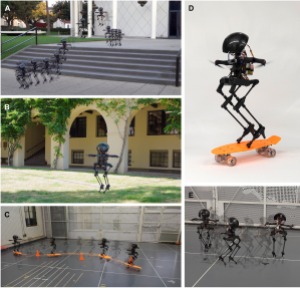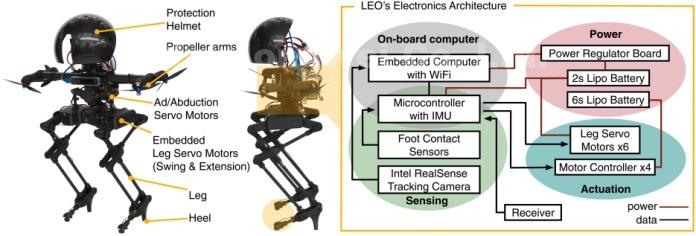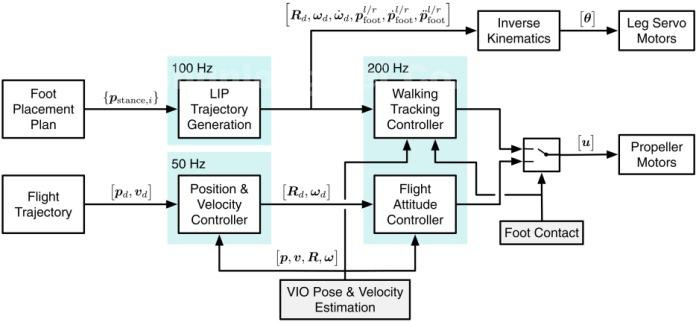Caltech’s bipedal robot walks, hops, flies, and skateboards
Engineers at the California Institute of Technology (Caltech) have created a part walking robot and part flying drone that reportedly can perform complex locomotion tasks beyond “simple walking and flying.” The LEONARDO (Legs ONboARD drOne, or LEO) bipedal robot can walk a slackline, hop, and ride a skateboard as well as fly thanks to its multimodal locomotion robotic platform.
By leveraging this hybrid locomotion capability, researchers said, it could open the door to a range of applications that are difficult for ground or aerial robots, such as multi-point inspection, repair, or replacement tasks in locations that are difficult for humans to reach as well as drive the development of adaptive landing gear systems comprised of controlled leg joints for aerial robots and other flying vehicles.
Researchers said the platform, which combines flying and walking locomotion regimes using synchronized control of distributed electric thrusters and a pair of multi-joint legs, enables the the complex movements, such as walking on a slackline or skateboarding, which are challenging for existing bipedal robots.

LEO’s locomotion maneuvers. Click for a larger image. (Source: Caltech)
Developed by a team at Caltech’s Center for Autonomous Systems and Technologies (CAST), LEO is said to be the first robot that uses multi-joint legs and propeller-based thrusters to achieve precision control over its balance. The research was reported in a paper published online at Science Robotics.
LEONARDO demonstrates walking motions with flying maneuvers to overcome obstacles using synchronized control of propellers and leg joints, which could potentially enable robotic missions and operations not possible for single-modal locomotion robots, according to the research paper. This means robots with multimodal locomotion switch between walking and flying modes as needed.
“Compared with a ground robot, LEO can overcome any obstacle using the transition between its ground and flying modes or easily reach an elevated location using propellers,” commented the researchers in the paper. “In addition, whereas an aerial robot can hover over targets, LEO can use its ground locomotion to approach them for closer inspection. When LEO is in ground contact or walking, it can also reject large disturbances and prevent falling even on extremely slippery surfaces by using synchronized control of its distributed propellers and leg joints, thereby allowing for more robust and precise walking motion.”
Here are the details. LEO has a height of 75 cm when walking and weighs 2.58 kg. It consists of three main subsystems: a torso, a propeller propulsion system, and two legs with point feet (see image below). It can operate autonomously thanks to its onboard computers and sensors. The nominal walking speed is 20 cm/s, though, researchers said, its ground speed can increase significantly by using intermittent flying while close to the ground.

Caption: LEO’s main electronics and mechanical components. Click for a larger image. (Source: Caltech)
Each leg has three servo motors (brushless DC motors) for actuation: one moves the leg structure, while the other two servo actuators drive the parallel leg mechanism. The BLDC motors incorporate high-reduction gearboxes and embedded position control. “The embedded position controller is precise and fast enough for LEO’s leg control due to the low inertia of the legs and the high bandwidth of the propeller controller that stabilizes the walking gait,” according to the researchers.
LEO also uses four symmetrically placed propellers at its shoulders for stabilizing and controlling the walking and flying maneuvers. “The propeller axes of rotation are selected to enable the generation of roll, pitch, and yaw moments in both positive and negative directions about the center of mass (CoM) for flying and about the current stance foot location for walking,” according to the paper.
The torso, which connects the arms and legs into one assembly, houses two onboard computers, multiple sensors, and two lithium polymer (LiPo) batteries for powering the system. One computer interfaces with the sensors, receive commands, estimates states based on the sensor readings, and computes the trajectories. The second computer, which runs the walking and altitude flight controllers, interfaces directly with the leg actuators and the propeller motor controller as well as an inertial measurement unit (IMU) for low-latency attitude information.

Caption: Control architecture of LEO. Click for a larger image. (Source: Caltech)
The Caltech team performed a number of tests both outdoors and indoors. These tests included walking on a flat terrain, synchronized flying and walking, walking and balancing on a slack rope, and riding a skateboard around traffic cones by using the thrust of its propellers.
Caltech reported that the researchers plan to create a more rigid leg design that can support more of the robot’s weight and increase the thrust force of the propellers as well as make the robot more autonomous. They also plan to add a newly developed drone landing control algorithm that uses deep neural networks that will help LEO have a better understanding of the environment to make its own decisions about the best combination of walking, flying, or hybrid motion.
Co-authors of the paper include Soon-Jo Chung, Bren Professor of Aerospace and Control and Dynamical Systems; Kyunam Kim, postdoctoral researcher at Caltech; Patrick Spieler, a former member of Chung’s group who is currently with the Jet Propulsion Laboratory, managed by Caltech for NASA; Elena-Sorina Lupu (MS ’21), graduate student at Caltech, and Alireza Ramezani, former Caltech postdoctoral scholar and currently an assistant professor at Northeastern University. This research was supported by the Caltech Gary Clinard Innovation Fund and Caltech’s Center for Autonomous Systems and Technologies.